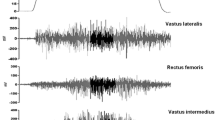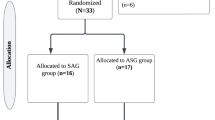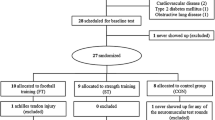Abstract
The objective was to determine the impact of a 1-year mixed strength-training programme on muscle function, functional ability, physical activity and life style. Twice-a-week hospital-based exercise classes and a once-a-week home session were conducted. Nineteen healthy community-dwelling training (T) men (76.6 ± 3.1 years), 19 women (77.5 ± 4.0 years) and 20 matched controls (C) participated in this study. Training was given with a two multi-gym machines for the lower limbs (Sitting calf and Leg press, TECHNOGYM, Italy) at 60% of the repetition maximum (1 RM) and at home it was with elastic bands. The following were the measurements made: muscle function—maximum isometric strength of the knee extensors (KE) and ankle plantar flexors (PF) measured with a Cybex Norm dynamometer, leg extensor power (LEP) with the Nottingham Power Rig; functional abilities—functional reach, chair rise, bed rise, 6-min walking test, stair climbing, get up and go, one-leg standing; physical activity—aerobic activities over 3 MET intensity (AA3), intensity classes; life-style—mean daily energy expenditure (MDEE). Significant gains in muscle function and functional abilities in both training females and males were observed, but females improved significantly more than males. Males (T + C) showed higher AA3 times than females (T + C) (P = 0.02), with females significantly more involved in light-intensity activities. We observed a 60% increase (t = 2.45) in AA3 time in T, but no increase in C. Trained males increased Class 2 physical activity time by 146% (t = 2.82) and trained females by 16% (t = 2.23). MDEE increased by 10% (t=2.62) in trained males. Our long-term mixed programme can improve muscle function and functional abilities in elderly females and functional abilities in males. It can positively affect the amount of habitual physical activity and the life-style of males and females over 75.

Similar content being viewed by others
References
ACSM (1998) The recommended quantity and quality of exercise for developing and mantaining cardiorespiratory and muscular fitness, and flexibility in healthy adults. Med Sci Sports Exerc 30(6):975–991
Aniansson A, Sperling L, Rundgren A, Lehnberg E (1983) Muscle function in 75-year-old men and women. A longitudinal study. Scand J Rehabil Med suppl 9:92–102
Åstrand PO, Rodahl K (1986) Textbook of work physiology. McGraw-Hill, New York
Bassey EJ, Ramsdale SJ (1993) Leg extensor power improves in women with feasible exercise programmes. J Physiol 467:121P
Bassey EJ, Short AH (1990) A new method for measuring power output in a single leg extension: feasibility, reliability and validity. Eur J Appl Physiol 60:385–390
Bassey EJ, Fiatarone MA, O’Neill EF, Kelly M, Evans WJ, Lipsitz LA (1992) Leg extensor power and functional performance in very old men and women. Clin Sci 82:321–327
Bean J, Kiely DK, Herman S et al (2002) The relationship between leg power and physical performance in mobility-limited elders. J Am Geriatr Soc 50:461–467
Bean J, Leveille SG, Kiely DK, Bandinelli S, Guralnik JM, Ferrucci L (2003) A comparison of leg power and leg strength within the In CHIANTI study: which influences mobility more? J Gerontol 58A(8):728–739
Berthouze SE et al (1995) Relationship between mean habitual daily energy expenditure and maximal oxygen uptake. Med Sci Sports Exerc 27(8):1170–1179
Bonnefoy M, Kostka T, Berthouze SE, Lacour JR (1996) Validation of a physical activity questionnaire in the elderly. J Appl Physiol 74:528–533
Butland RJA, Pang J, Gross ER, Woodcock AA, Geddes DM (1982) Two-, six, and 12-minute walking tests in respiratory disease. BMJ 284:1607–1608
Capodaglio EM, Aranda S, Lanfranconi F (2001) Primi risultati di uno studio per la validazione in lingua italiana di un questionario informatizzato di attivita’ fisica (Paqap). In: Atti del Congresso Nazionale Specialisti in Medicina dello Sport; June 24–27; Chieti, Italy
Capodaglio P, Facioli M, Burroni E, Giordano A, Ferri A, Scaglioni G (2002) Effectiveness of a home-based strengthening program for elderly males in Italy. A preliminary study. Aging Clin Exp Res 14:28–34
Carmeli E, Orbach P, Lowenthal DT, Merrick J, Coleman R (2003) Long-term effects of activity status in the elderly on cardiorespiratory capacity, blood pressure, blood lipids, and body composition: a five-year follow-up study. Sci World J 3:751–67
Cress ME, Thomas DP; Johnson J, Kasch FW, Cassens RG, Smith EL, Agre JC (1991) Effect of training on VO2 max, thigh strength, and muscle morphology in septuagenarian women. Med Sci Sports Exerc 23:752–78
Csuka M, McCarthy DJ (1991) Simple method for measurement of lower extremity muscle strength. Am J Med 78:77–81
Duncan PW, Weiner DK, Chandler J et al (1990) Functional reach: a new clinical measure of balance. J Gerontol (Med Sci) 45:M192–M197
Earles DR, Judge JO, Gunnarsson OT (2001) Velocity training induces power-specific adaptations in highly functioning older adults. Arch Phys Med Rehabil 82(7):872–878
Enright PL, Sherrill DL (1998) Reference equations for the 6-minute walk in healthy adults. Am J Respir Crit Care Med 158:1384–1387
Ferrucci L, Guralnik JM, Buchner D et al (1997) Departures from linearity in the relationship between measures of muscular strength and physical performance of the lower extremities: the women’s health and ageing study. J Gerontol Med Sci 52:M275–M285
Foldavari M, Clark M, Laviolette MJA et al (1999) Association of muscle power with functional status in community dwelling elderly women. Med Sci Sports Exerc 31:S378
Häkkinen K, Kallinen M, Izquierdo M et al (1984) Changes in agonist-antagonist EMG, muscle CSA, and force during strength training in middle-aged and older people. J Appl Physiol 1198:1341–1349
Jackson AS, Beard EF, Wier LT, Ross RM, Stuteville JE, Blair SN (1995) Changes in aerobic power of men ages 25–70 year. Med Sci Sports Exerc 27:113–120
Jozsi AC, Campbell WW, Joseph L, Davey SL, Evans WJ (1999) Changes in power output with resistance training in older and younger men and women. J Gerontol A Biol Sci Med Sci 54:M591–M596
Keysor JJ (2003) Does late-life physical activity or exercise prevents or minimize disablement? Am J Prev Med 25:129–136
Krems C., Lührmann P. M., Neuhäuser-Berthold M (2004) Physical activity in young and elderly subjects. J Sport Med Phys Fitness 44(1):71–78
Latham NK, Bennet DA, Stretton CM, Anderson CS (2004) Systematic review of progressive resistance strength training in older adults. J Gerontol Med Sci 59:48–61
Macaluso A, Young A, Gibb KS, Rowe DA, De Vito G (2003) Cycling as a novel approach to resistance training increases muscle strength, power and selected functional abilities in healthy older women. J Appl Physiol 95(6):2544–2553
Malbut KF, Greig CA, Pippet B et al (1993) Training exercise increases strength and power in very elderly women. Clin Sci 81(29):16P
Malbut KE, Dinan S, Young A (2002) Aerobic training in the ‘oldest old’: the effect of 24 weeks of training. Age Ageing 31:255–260
Mathias S, Nayak USL, Isaacs B (1986) Balance in elderly patients: the ‘Get up and go’ test. Arch Phys Med Rehabil 67:387–389
McArdle WD, Katch FI, Katch VL (1982) Exercise physiology: energy, nutrition, and human performance. Lea and Febiger, Philadelphia
McMurdo MET, Johnstone R (1995) A randomized controlled trial of a home exercise programme for elderly people with poor mobility. Age Ageing 24:425–428
Liu B, Woo J, Tang N, Ng K, Ip R, Yu A (2001) Assessment of total energy expenditure in a Chinese population by a physical activity questionnaire: examination of validity. Int J Food Sci Nutr 52(3):269–282
Podsiadlo D, Richardson S (1991) The timed ‘Up & Go’: a test of basic functional mobility for frail elderly persons. J Am Geriatr Soc 39:142–148
Pyka G, Lindenberger E, Charette S, Marcus R (1994) Muscle strength and fiber adaptations to a year-long resistance training program in elderly men and women. J Gerontol 49:M22–M27
Roth SM, Ivey FM. Martel GF et al (2001) Muscle size responses in strength training in young and older men and women. J Am Geriatr Soc 49:1428–1433
Shephard RJ (1991) Fitness and aging. In: Blais C (eds) Aging in the twenty-first century. Captus University, Downsview
Skelton DA, Grieg CA, Davies JM et al (1994) Strength, power and related functional ability of healthy people aged 65–89 years. Age Ageing 23:371–377
Sports Council and Health Education Authority (1992) Allied Dubar National Fitness Survey: a report on activity patterns and fitness levels. Sports Council and Health Education Authority, London
Suzuki T, Bean J, Fielding R (2001) Muscle strength and power of the ankle plantar and dorsi flexors predict functional performance in community dwelling older women. J Am Geriatr Soc 49:1161–1167
van der Bij A, Laurant GHM, Wensing M (2002) Effectiveness of physical activity interventions for older adults. Am J Prev Med 22(2):120–133
Vellas BJ, Rubenstein LZ, Ousset PJ, Faisant C, Kostek V, Nourhashemi F, Allard M, Albarede JL (1997) One-leg standing balance and functional status in a population of 512 community-living elderly persons. Aging Clin Exp Res 9:95–98
Vincent KR, Braith RW, Feldman RA, Magyari PM, Cutler RB, Persin SA, Lennon SL, Gabr AH, Lowenthal DT (2002) Resistance exercise and physical performance in adults aged 60 to 83. J Am Geriatr Soc 50:1081–1100
Acknowledgments
The support given by Technogym Italy is acknowledged. The authors are indebted to the participants in this study for the commitment given to this project.
Author information
Authors and Affiliations
Corresponding author
Additional information
This study was supported by EC Contract QLK6-CT-2001-00323 (“Better Ageing”).
Rights and permissions
About this article
Cite this article
Capodaglio, P., Capodaglio Edda, M., Facioli, M. et al. Long-term strength training for community-dwelling people over 75: impact on muscle function, functional ability and life style. Eur J Appl Physiol 100, 535–542 (2007). https://doi.org/10.1007/s00421-006-0195-8
Accepted:
Published:
Issue Date:
DOI: https://doi.org/10.1007/s00421-006-0195-8




